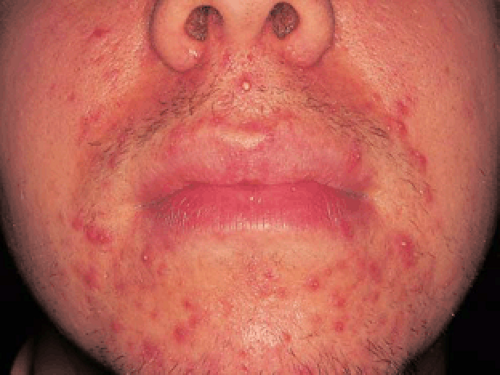Acne Vulgaris
James C. Shaw
(ICD-9 706.1)
Symptoms and Signs
Acne vulgaris is usually asymptomatic, although the large nodular lesions can be tender. Patients usually present during adolescence with comedones, papules, pustules, nodules, or a combination of these. Closed come dones (whiteheads) and open comedones (blackheads) represent keratin-plugged hair follicles. The dark color is due to oxidation of surface keratin. Papules and pustules are 2 to 4 mm in diameter and have a slightly erythematous base (Fig. 9-1).
The nodules are deeper, erythematous lesions ranging from 6 to 20 mm in diameter (Fig. 9-2) and occur on the face, neck, back, and chest. The term “cystic acne” is inaccurate and has been replaced by “severe nodular acne” as the preferred nomenclature. Acne is not limited to adolescence and commonly manifests for the first time in adulthood, especially in women.
Differential Diagnosis
Due to chemical exposures (aromatic chlorinated hydrocarbons such as dioxin and herbicides), comedones cause extensive face and neck lesions. Papules and pustules can be seen in rosacea, bacterial folliculitis, or “steroid acne” that is caused by systemic or topical corticosteroids. A culture of the papules may be required to exclude bacterial folliculitis.
 Figure 9-1 Acne vulgaris. Inflammatory papules and pustules.
Stay updated, free articles. Join our Telegram channel
Full access? Get Clinical Tree
 Get Clinical Tree app for offline access
Get Clinical Tree app for offline access

|





